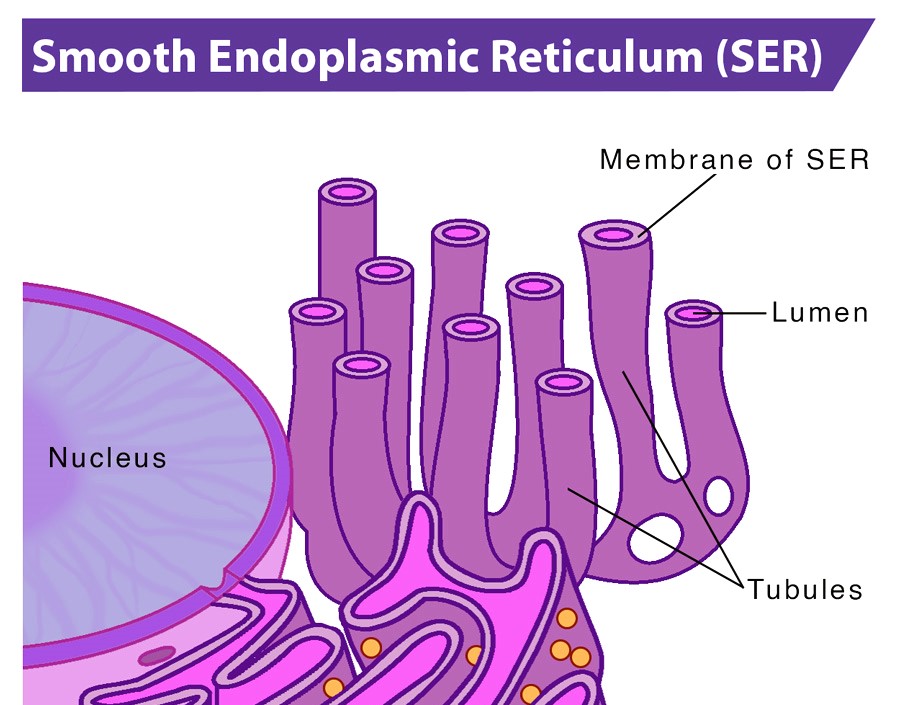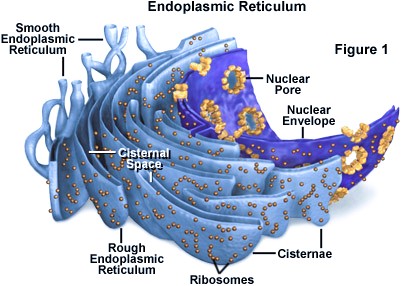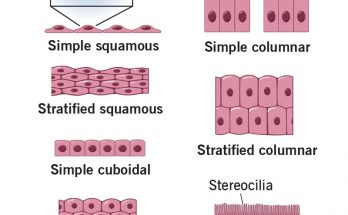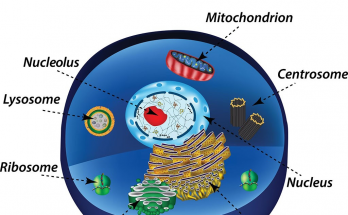Rough and Smooth Endoplasmic Reticulum
The endoplasmic reticulum (ER) is a vital part of eukaryotic cells, acting as a hub for producing and transporting proteins, fats, and other crucial molecules. Not all cells have an ER; for example, red blood cells lack this structure. However, cells involved in protein and oil production usually contain large amounts of ER.
There are two types of ER-
- The Rough Endoplasmic Reticulum (RER) and
- The Smooth Endoplasmic Reticulum (SER).
The Rough Endoplasmic Reticulum (RER) and The Smooth Endoplasmic Reticulum (SER) Look- The RER is called ‘rough’ because it has tiny machines called ribosomes attached to it, making it look bumpy. These ribosomes are like little builders that make proteins. On the other hand, the SER is smooth because it doesn’t have these ribosomes.What They Do- The Rough Endoplasmic Reticulum (RER)is mainly a place where proteins are made. These proteins are important for many functions in our body, like acting as messengers or building structures. The Smooth Endoplasmic Reticulum (SER) has a different job. It doesn’t make proteins but instead helps make fats (like oils and steroids) and also deals with carbohydrates.
Also Check – Cell Organelles – The complete Guide
Difference between Rough and Smooth Endoplasmic Reticulum
| Aspects | Smooth Endoplasmic Reticulum (SER) | Rough endoplasmic reticulum (RER) |
|---|---|---|
| Presence of Ribosomes | Does not have ribosomes on its surface. | Has ribosomes attached to its surface. |
| Structure | Composed of vesicles and tubules. | Made up of cisternae (flattened sacs) and some tubules. |
| Primary Function | Involved in the synthesis of lipids, including oils, phospholipids, and steroids. | Primarily engaged in the production of proteins. |
| Role in Organelle Formation | Leads to the formation of Spherosomes/Oleosomes (lipid storage bodies). | Contributes to the creation of lysosomes (digestive organelles). |
| Location in the Cell | Typically located near the cell membrane. | Generally situated near the nucleus and connected to the nuclear envelope. |
| Ribophorins | Lacks Ribophorins. | Contains Ribophorins which help in attaching ribosomes to the ER. |
| Developmental Origin | Can develop from the Rough Endoplasmic Reticulum. | May originate from the nuclear envelope. |
| Interaction with Golgi Apparatus | Supplies vesicles to the Golgi apparatus’s cis-face. | Provides proteins and lipids to the Golgi apparatus. |
| End Products | Produces lipids, steroids, and carbohydrates like glycogen. | Mainly produces proteins, including enzymes. |
| Diagram |  |  |
9 Important Difference between Rough and Smooth Endoplasmic Reticulum Explained in Details
Difference between Rough and Smooth Endoplasmic Reticulum in terms of Presence of Ribosomes-
- Smooth Endoplasmic Reticulum (SER)– The SER does not have ribosomes on its surface. This absence of ribosomes gives it a smooth appearance when viewed under an electron microscope, which is why it is called ‘smooth’ ER.
- Rough Endoplasmic Reticulum (RER)- In contrast, the RER has ribosomes attached to its surface. These ribosomes give the RER a rough appearance under an electron microscope, leading to its name ‘rough’ ER.
Difference between Rough and Smooth Endoplasmic Reticulum in terms of Structure-
- Smooth Endoplasmic Reticulum (SER)– The SER is formed of vesicles and tubules. This structure is more tubular and branched, and it lacks the ribosomes that are characteristic of the RER. This structure is conducive to its functions, which include lipid synthesis and carbohydrate metabolism.
- Rough Endoplasmic Reticulum (RER)- The RER, on the other hand, is formed of cisternae (flattened sacs) and a few tubules. The presence of ribosomes on the surface of these cisternae is what gives the RER its rough appearance. The RER’s structure is well-suited for its primary role in protein synthesis.
Difference between Rough and Smooth Endoplasmic Reticulum in terms of Primary Function-
- Smooth Endoplasmic Reticulum (SER)– The primary function of the SER is the synthesis of lipids, including oils, phospholipids, and steroids. It is also involved in carbohydrate metabolism and the detoxification of drugs and poisons. Additionally, the SER plays a crucial role in the storage of ions and the production of steroid hormones in certain cells.
- Rough Endoplasmic Reticulum (RER)- The RER’s main function is to synthesise proteins. These proteins are usually destined for export out of the cell, incorporation into the cell membrane, or for use within the cell. The RER is particularly important in cells that secrete large amounts of proteins, like antibody-producing cells and digestive gland cells.
Difference between Rough and Smooth Endoplasmic Reticulum in terms of Role in Organelle Formation-
- Smooth Endoplasmic Reticulum (SER)– The Smooth Endoplasmic Reticulum is responsible for giving rise to Spherosomes or Oleosomes. These are organelles involved in lipid storage within the cell. Their formation from the SER is linked to the SER’s role in lipid metabolism.
- Rough Endoplasmic Reticulum (RER)- The Rough Endoplasmic Reticulum, on the other hand, assists in the formation of lysosomes. Lysosomes are cellular organelles that contain digestive enzymes. They are essential for breaking down various types of biomolecules, which is a process closely related to the protein synthesis function of the RER.
Difference between Rough and Smooth Endoplasmic Reticulum in terms of Location in the Cell-
- Smooth Endoplasmic Reticulum (SER)– This organelle is typically found in the peripheral regions of the cell and may be connected to the plasmalemma (cell membrane). Its location reflects its roles in lipid synthesis and metabolism, as well as in the detoxification processes.
- Rough Endoplasmic Reticulum (RER)- The RER is typically located internally within the cell and is often connected with the nuclear envelope. This positioning is significant for its role in protein synthesis, as it facilitates the transfer of messenger RNA from the nucleus to the ribosomes on the RER.
Difference between Rough and Smooth Endoplasmic Reticulum in terms of Ribophorins-
- Smooth Endoplasmic Reticulum (SER)– The Smooth Endoplasmic Reticulum does not contain Ribophorins. Ribophorins are proteins that play a crucial role in attaching ribosomes to the endoplasmic reticulum, and their absence in the SER is consistent with the lack of ribosomes on its surface.
- Rough Endoplasmic Reticulum (RER)- In contrast, the Rough Endoplasmic Reticulum contains Ribophorins. These proteins are essential for the attachment of ribosomes to the endoplasmic reticulum, a defining feature of the RER. The presence of Ribophorins is key to the RER’s function in protein synthesis.
Difference between Rough and Smooth Endoplasmic Reticulum in terms of Developmental Origin-
- Smooth Endoplasmic Reticulum (SER)– The Smooth Endoplasmic Reticulum typically develops from the Rough Endoplasmic Reticulum. This development occurs when ribosomes attached to the RER are lost, leading to the formation of the smooth structure of the SER. This process reflects the dynamic nature of the cell’s internal structures, adapting to its specific metabolic needs.
- Rough Endoplasmic Reticulum (RER)- The Rough Endoplasmic Reticulum may develop from the nuclear envelope. This relationship is significant as the nuclear envelope is also studded with ribosomes and is involved in the synthesis of nuclear membrane components. The proximity of the RER to the nucleus facilitates the efficient transfer of genetic information for protein synthesis.
Difference between Rough and Smooth Endoplasmic Reticulum in terms of Interaction with Golgi Apparatus-
- Smooth Endoplasmic Reticulum (SER)- The SER provides vesicles for the cis-face of the Golgi apparatus. These vesicles are crucial for transporting materials, such as lipids and proteins, from the SER to the Golgi apparatus for further modification, sorting, and packaging. This interaction underscores the role of the SER in lipid metabolism and transport within the cell.
- Rough Endoplasmic Reticulum (RER)- The RER, in contrast, provides proteins and lipids for the Golgi apparatus. The proteins synthesised in the RER are transported to the Golgi apparatus for further processing, such as glycosylation, sorting, and packaging into vesicles for transport to their final destinations. This highlights the RER’s central role in the cell’s protein synthesis and secretory pathways.
Difference between Rough and Smooth Endoplasmic Reticulum in terms of End Products-
- Smooth Endoplasmic Reticulum (SER)- The SER primarily produces lipids, steroids, and sometimes carbohydrates like glycogen. These products are essential for various cellular functions, including membrane formation, energy storage, and hormone synthesis. The SER’s role in lipid and steroid synthesis is particularly prominent in cells of the adrenal glands and liver.
- Rough Endoplasmic Reticulum (RER)- The main end products of the RER are proteins. These proteins include enzymes, hormones, and structural proteins that are essential for the cell’s function. The RER is especially active in cells that are heavily involved in protein synthesis, such as antibody-producing cells and pancreatic cells.
Curious Queries on Rough and Smooth Endoplasmic Reticulum
Question- Why is the Rough Endoplasmic Reticulum rough?
- Answer- The Rough Endoplasmic Reticulum (RER) looks rough because it has lots of tiny structures called ribosomes attached to its surface. These ribosomes are like little factories where proteins are made, and they give the RER its bumpy, rough appearance.
Question- What does the Smooth Endoplasmic Reticulum do?
- Answer- The Smooth Endoplasmic Reticulum (SER) has several important jobs. It helps make and store fats and steroids, which are types of lipids. It also helps detoxify chemicals and store important minerals for the cell.
Question- Can one cell have both types of Endoplasmic Reticulum?
- Answer- Yes, many cells have both Smooth and Rough Endoplasmic Reticulum. They work together but do different jobs within the cell. It’s like having different departments in a factory, each doing its own specialized task.
Question- Why don’t red blood cells have Endoplasmic Reticulum?
- Answer- Red blood cells are unique because they don’t have a nucleus or other organelles like the Endoplasmic Reticulum when they are mature. This gives them more space to carry oxygen throughout your body.
Question- Can the Smooth Endoplasmic Reticulum turn into the Rough Endoplasmic Reticulum?
- Answer– Yes, the Smooth Endoplasmic Reticulum can change into Rough Endoplasmic Reticulum and vice versa. This happens depending on the cell’s needs. If a cell needs to make more proteins, some parts of the SER might get ribosomes and turn into RER.
Question- How do scientists see the Endoplasmic Reticulum?
- Answer- Scientists use very powerful microscopes called electron microscopes to see the Endoplasmic Reticulum. These microscopes can see really tiny things, much smaller than what we can see with our eyes or even regular microscopes.
Question- Do plants have Smooth and Rough Endoplasmic Reticulum too?
- Answer- Yes, plant cells also have both Smooth and Rough Endoplasmic Reticulum. Just like in animal cells, they have different roles in helping the plant cell function properly.
Question- Is the Endoplasmic Reticulum connected to the nucleus of the cell?
- Answer- The Rough Endoplasmic Reticulum is often connected to the nucleus of the cell. This helps in quickly transporting the genetic messages from the nucleus to the RER, where proteins are made.
Question- What happens to the proteins made in the Rough Endoplasmic Reticulum?
- Answer- The proteins made in the Rough Endoplasmic Reticulum (RER) are often sent to other parts of the cell where they are needed. Some are transported to the cell membrane to be part of it, others are sent outside the cell, and some are used within the cell itself for various functions.
Question- Does the Smooth Endoplasmic Reticulum help in digestion?
- Answer- The Smooth Endoplasmic Reticulum (SER) doesn’t directly help in digestion like the stomach does. However, it does have a role in breaking down certain chemicals and drugs in liver cells, which can be considered a form of detoxification or ‘cleaning’ process in the body.
Question- Are the Smooth and Rough Endoplasmic Reticulum the same size?
- Answer- The size of the Smooth and Rough Endoplasmic Reticulum can vary depending on the type of cell and what the cell needs to do. In some cells, the RER might be larger if a lot of protein synthesis is needed. In others, the SER might be more prominent if there’s a greater need for lipid synthesis or detoxification.
Question- Can we live without the Endoplasmic Reticulum?
- Answer- No, we cannot live without the Endoplasmic Reticulum. It’s essential for many cell functions, like making proteins and lipids, which are crucial for the survival and proper functioning of our cells and, therefore, our body.
Question- What would happen if the Rough Endoplasmic Reticulum stopped working?
- Answer- If the Rough Endoplasmic Reticulum stopped working, the cell would not be able to make many important proteins. This would lead to problems in the cell and the overall function of the organism. It could affect everything from muscle function to the production of digestive enzymes.
Question- Why is the Endoplasmic Reticulum important for nerve cells?
- Answer- In nerve cells, the Endoplasmic Reticulum is important for producing and regulating the chemicals needed for transmitting nerve signals. It also helps in maintaining the health of the cell’s membrane, which is crucial for nerve cell communication.
Also Check – 7 Difference Between Mitochondria and Endoplasmic Reticulum
Also Check – 11 Important Functions of Endoplasmic Reticulum (ER) Class 9
Also Check – 16 Important Differences between Prokaryotic and Eukaryotic cell



7 Comments on “9 Important Difference between Rough and Smooth Endoplasmic Reticulum”